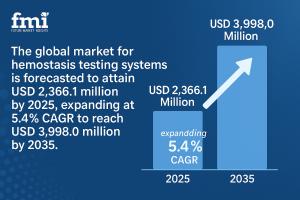Global Hemostasis Testing Systems Market: A Rapidly Advancing Frontier in Diagnostic Technology | FMI
Hemostasis Testing Systems Market projected to grow significantly from 2025 to 2035, driven by rising demand for advanced diagnostics.
Why Hemostasis Testing is in the Spotlight
Hemostasis testing systems play a vital role in detecting, diagnosing, and monitoring conditions related to blood clotting. Disorders like hemophilia, deep vein thrombosis (DVT), factor V deficiency, and pulmonary embolism are becoming more prevalent globally. As the population ages, the risk of developing these conditions increases, necessitating accurate and timely diagnostic solutions.
Access Key Market Insights: Request a Sample Report Now! https://www.futuremarketinsights.com/reports/sample/rep-gb-1331
Surgical interventions and trauma cases also call for rapid evaluation of a patient’s coagulation profile, increasing the demand for real-time, high-precision diagnostic tools. The market is leaning into automation and AI to deliver faster results, reduce human error, and accommodate the growing volume of tests being performed.
Technological Innovations: A Game Changer
One of the most defining aspects of the market’s evolution is the rise of automated hemostasis analyzers and point-of-care (POC) testing devices. These innovations significantly improve test efficiency, minimize turnaround time, and streamline workflows in hospital labs and clinics.
Technological advancements such as AI integration, microfluidic platforms, and lab-on-a-chip systems are setting new standards for diagnostic performance. These solutions enhance diagnostic accuracy, reduce costs, and are increasingly favored in both developed and emerging markets.
Furthermore, gender-specific therapies and marker-based coagulation diagnostics are poised to shape the future of personalized medicine, further driving demand for sophisticated hemostasis testing systems.
Country-Wise Analysis: Global Trends and Regional Insights
United States: A Mature Yet Expanding Market
The U.S. market remains one of the most advanced globally, with growth driven by:
• High prevalence of bleeding disorders such as hemophilia and Von Willebrand disease
• A surge in surgical procedures, particularly cardiovascular and orthopedic operations
• Increased demand for POC testing in emergency and critical care settings
• Availability of reimbursement policies that encourage diagnostic testing
With a CAGR of 3.7% from 2025 to 2035, the U.S. market will continue to expand due to its robust healthcare infrastructure and high technology adoption.
Soaring Demand for Market Information: Uncover Detailed Trends and Insights in Our Report! https://www.futuremarketinsights.com/reports/hemostasis-testing-systems-market
Germany: Innovation-Driven Growth
Germany’s market is characterized by its well-developed healthcare system and an ongoing commitment to automation in diagnostic laboratories. The country is at the forefront of precision therapy adoption, which requires detailed coagulation profiling.
Factors driving growth in Germany include:
• An emphasis on new technology implementation
• A high incidence of cardiovascular diseases
• Supportive government policies encouraging preventive diagnostics
The market is expected to grow at a CAGR of 4.3% through 2035.
China: Poised for Exponential Growth
China presents the fastest growing market for hemostasis testing systems, with a CAGR of 6.3%. Factors contributing to this growth include:
• A rapidly aging population
• Government-backed healthcare reforms and infrastructure investments
• Increasing adoption of AI-powered diagnostics
• A shift towards personalized medicine and tailored anticoagulant therapy
China’s push to become a leader in medtech, along with rising awareness and diagnostic capability, sets a fertile ground for market expansion.
India: A Fast-Emerging Diagnostic Hub
India’s hemostasis testing systems market is growing rapidly, with a CAGR of 7.1%—the highest among all countries analyzed. Key factors include:
• A high burden of blood disorders
• Rapid healthcare infrastructure development
• Government initiatives to enhance diagnostic services
• Increased access to affordable diagnostic tools
The presence of international healthcare seekers and a growing domestic patient base further contributes to market penetration.
Brazil: Strong Public Sector and Growing Awareness
Brazil’s market is benefiting from public health initiatives and growing awareness of bleeding disorders. With a CAGR of 5.3%, the country is expected to make steady gains through:
• Expansion of public and private diagnostic services
• Rising POC testing adoption
• Government support for universal health coverage
• Increased need for anticoagulation therapy monitoring
Brazil’s strengthening healthcare system and proactive disease management strategies offer promising opportunities for diagnostic equipment providers.
The Road Ahead: Embracing Smart Diagnostics
As we look toward the future, several trends are poised to shape the trajectory of the global hemostasis testing systems market:
1. Integration of AI and Machine Learning: To predict coagulation anomalies and optimize therapy in real time.
2. Portable and User-Friendly Devices: For use in remote areas and decentralized healthcare setups.
3. Increased Investment in R&D: Both public and private sectors are channeling funds into the development of smarter, faster, and more affordable diagnostic solutions.
4. Personalized Medicine: Coagulation tests will play a critical role in tailoring treatment plans, especially in chronic illness management.
5. Global Health Policy Shifts: With governments prioritizing preventive care, hemostasis testing is set to gain prominence in early disease detection programs.
Conclusion
The global hemostasis testing systems market is on the cusp of transformative growth. With an expected market value of USD 3,998.0 million by 2035, driven by technology, demographic shifts, and healthcare policy reforms, this segment holds tremendous promise. Regional markets—from the technologically advanced U.S. and Germany to the rapidly developing landscapes of China, India, and Brazil—are all witnessing substantial momentum.
Healthcare providers, policymakers, and diagnostic manufacturers must work collaboratively to capitalize on these trends. The future of hemostasis diagnostics lies not only in innovation but also in equitable access, clinical integration, and patient-centric design. As bleeding disorders and thrombotic conditions continue to rise, the need for accurate, timely, and accessible testing solutions becomes not just a market opportunity but a global healthcare imperative.
Explore FMI’s Related Ongoing Coverage on Healthcare Market Insights Domain:
Hemostasis Products Market Insights - Trends & Forecast 2025 to 2035: https://www.futuremarketinsights.com/reports/hemostasis-product-market
HPV Testing and Pap Test Market Analysis – Size, Share & Forecast 2022-2032: https://www.futuremarketinsights.com/reports/hpv-testing-and-pap-test-market
Self-Testing Market Share Analysis Outlook from 2025 to 2035: https://www.futuremarketinsights.com/reports/self-testing-market-share-analysis
About Future Market Insights (FMI)
Future Market Insights, Inc. (ESOMAR certified, recipient of the Stevie Award, and a member of the Greater New York Chamber of Commerce) offers profound insights into the driving factors that are boosting demand in the market. FMI stands as the leading global provider of market intelligence, advisory services, consulting, and events for the Packaging, Food and Beverage, Consumer Technology, Healthcare, Industrial, and Chemicals markets. With a vast team of over 400 analysts worldwide, FMI provides global, regional, and local expertise on diverse domains and industry trends across more than 110 countries.
Contact Us:
Future Market Insights Inc.
Christiana Corporate, 200 Continental Drive,
Suite 401, Newark, Delaware - 19713, USA
T: +1-347-918-3531
For Sales Enquiries: sales@futuremarketinsights.com
Website: https://www.futuremarketinsights.com
LinkedIn| Twitter| Blogs | YouTube
Ankush Nikam
Future Market Insights, Inc.
+91 90966 84197
email us here
Visit us on social media:
LinkedIn
Facebook
YouTube
X
Legal Disclaimer:
EIN Presswire provides this news content "as is" without warranty of any kind. We do not accept any responsibility or liability for the accuracy, content, images, videos, licenses, completeness, legality, or reliability of the information contained in this article. If you have any complaints or copyright issues related to this article, kindly contact the author above.
Jason McDonald Consulting Announces New Online Class in Digital Marketing (SEO, Social Media, and Online Ads)
Military Robots Market Showing Impressive Growth During Forecast Period 2021 – 2030
Duco Consultancy Honored as a Regional System Integrator of the Year for Asia Pacific and Japan by Stibo Systems
Kalendarium
Więcej ważnych informacji
 Jedynka Newserii
Jedynka Newserii

 Jedynka Newserii
Jedynka Newserii

Konsument

Dzięki e-commerce rośnie eksport polskich małych i średnich przedsiębiorców. Wartość ich sprzedaży na Amazon przekracza rocznie 5 mld zł
Mali i średni przedsiębiorcy coraz lepiej radzą sobie na arenie międzynarodowej, choć na razie tylko niecałe 5 proc. z nich sprzedaje swoje produkty za granicę. Duże możliwości ekspansji zagranicznej dają im e-commerce i współpraca z marketplace’ami. Za pośrednictwem Amazon w 2024 roku polskie MŚP sprzedały produkty za ponad 5,1 mld zł. Model sprzedaży sklepu umożliwia przedsiębiorcom z Polski działanie na skalę, która jeszcze kilka lat temu wydawała się zarezerwowana głównie dla największych marek
Polityka
Większość Polaków sprzeciwia się wprowadzeniu euro. Problemem może być brak dobrej komunikacji

– Polska należy do siedmiu krajów UE, które do tej pory nie wprowadziły jeszcze euro. Choć zobowiązaliśmy się do przyjęcia wspólnej waluty w traktacie akcesyjnym, nigdy nie podjęliśmy konsekwentnych działań w tym kierunku – ocenia europosłanka Nowej Lewicy Joanna Scheuring-Wielgus. W dodatku tylko co czwarty Polak jest zwolennikiem zmiany waluty. Również obecna sytuacja gospodarcza – wysoka inflacja i rosnący deficyt – nie sprzyjają dyskusji o przyjęciu euro.
Handel
Źle wprowadzony system ROP może oznaczać duży wzrost cen dla konsumentów. Podrożeć mogą produkty spożywcze

Ministerstwo Klimatu i Środowiska proponuje powierzenie NFOŚiGW zadań organizacji odpowiedzialności producenta, która w imieniu producentów będzie realizowała obowiązki wynikające z ROP w ramach zamkniętego obiegu finansowego. Przedstawiciele Polskiej Federacji Producentów Żywności i sektora odzysku odpadów ostrzegają, że może utrudnić to Polsce wypełnienie unijnych wymogów w zakresie selektywnej zbiórki odpadów, a co za tym idzie, może się wiązać z karami, a w konsekwencji – ze wzrostem cen.
Partner serwisu
Szkolenia

Akademia Newserii
Akademia Newserii to projekt, w ramach którego najlepsi polscy dziennikarze biznesowi, giełdowi oraz lifestylowi, a także szkoleniowcy z wieloletnim doświadczeniem dzielą się swoją wiedzą nt. pracy z mediami.









.gif)

 |
| |
| |
|